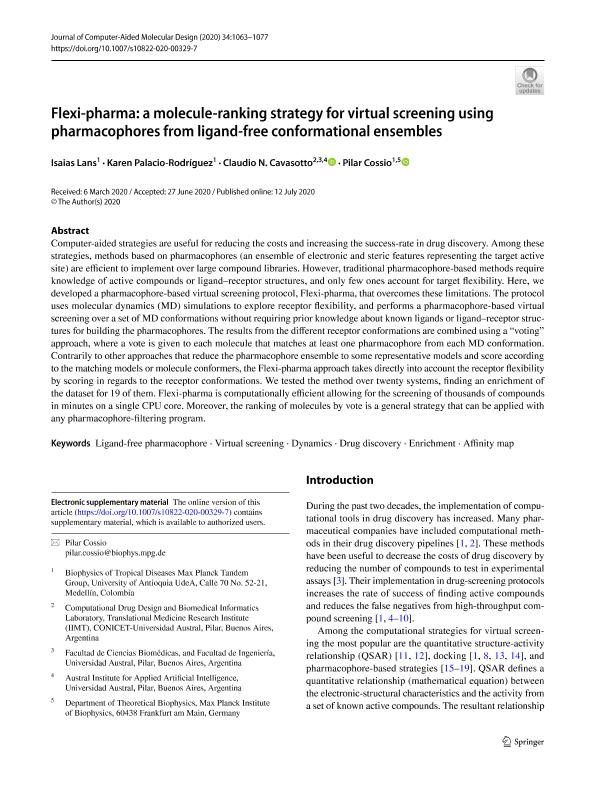Mostrar el registro sencillo del ítem
dc.contributor.author
Lans, Isaias
dc.contributor.author
Palacio Rodríguez, Karen
dc.contributor.author
Cavasotto, Claudio Norberto

dc.contributor.author
Cossio, Pilar
dc.date.available
2023-01-12T13:27:33Z
dc.date.issued
2020-07
dc.identifier.citation
Lans, Isaias; Palacio Rodríguez, Karen; Cavasotto, Claudio Norberto; Cossio, Pilar; Flexi-pharma: a molecule-ranking strategy for virtual screening using pharmacophores from ligand-free conformational ensembles; Springer; Journal of Computer-Aided Molecular Design; 34; 10; 7-2020; 1063-1077
dc.identifier.issn
0920-654X
dc.identifier.uri
http://hdl.handle.net/11336/184518
dc.description.abstract
Computer-aided strategies are useful for reducing the costs and increasing the success-rate in drug discovery. Among these strategies, methods based on pharmacophores (an ensemble of electronic and steric features representing the target active site) are efficient to implement over large compound libraries. However, traditional pharmacophore-based methods require knowledge of active compounds or ligand–receptor structures, and only few ones account for target flexibility. Here, we developed a pharmacophore-based virtual screening protocol, Flexi-pharma, that overcomes these limitations. The protocol uses molecular dynamics (MD) simulations to explore receptor flexibility, and performs a pharmacophore-based virtual screening over a set of MD conformations without requiring prior knowledge about known ligands or ligand–receptor structures for building the pharmacophores. The results from the different receptor conformations are combined using a “voting” approach, where a vote is given to each molecule that matches at least one pharmacophore from each MD conformation. Contrarily to other approaches that reduce the pharmacophore ensemble to some representative models and score according to the matching models or molecule conformers, the Flexi-pharma approach takes directly into account the receptor flexibility by scoring in regards to the receptor conformations. We tested the method over twenty systems, finding an enrichment of the dataset for 19 of them. Flexi-pharma is computationally efficient allowing for the screening of thousands of compounds in minutes on a single CPU core. Moreover, the ranking of molecules by vote is a general strategy that can be applied with any pharmacophore-filtering program.
dc.format
application/pdf
dc.language.iso
eng
dc.publisher
Springer

dc.rights
info:eu-repo/semantics/openAccess
dc.rights.uri
https://creativecommons.org/licenses/by/2.5/ar/
dc.subject
AFFINITY MAP
dc.subject
DRUG DISCOVERY
dc.subject
DYNAMICS
dc.subject
ENRICHMENT
dc.subject
LIGAND-FREE PHARMACOPHORE
dc.subject
VIRTUAL SCREENING
dc.subject.classification
Otras Ciencias Químicas

dc.subject.classification
Ciencias Químicas

dc.subject.classification
CIENCIAS NATURALES Y EXACTAS

dc.title
Flexi-pharma: a molecule-ranking strategy for virtual screening using pharmacophores from ligand-free conformational ensembles
dc.type
info:eu-repo/semantics/article
dc.type
info:ar-repo/semantics/artículo
dc.type
info:eu-repo/semantics/publishedVersion
dc.date.updated
2021-09-07T15:19:18Z
dc.journal.volume
34
dc.journal.number
10
dc.journal.pagination
1063-1077
dc.journal.pais
Alemania

dc.journal.ciudad
Berlin
dc.description.fil
Fil: Lans, Isaias. Universidad de Antioquia; Colombia
dc.description.fil
Fil: Palacio Rodríguez, Karen. Universidad de Antioquia; Colombia
dc.description.fil
Fil: Cavasotto, Claudio Norberto. Universidad Austral. Facultad de Ciencias Biomédicas. Instituto de Investigaciones en Medicina Traslacional. Consejo Nacional de Investigaciones Científicas y Técnicas. Oficina de Coordinación Administrativa Parque Centenario. Instituto de Investigaciones en Medicina Traslacional; Argentina
dc.description.fil
Fil: Cossio, Pilar. Max Planck Institute Of Biophysics; Alemania. Universidad de Antioquia; Colombia
dc.journal.title
Journal of Computer-Aided Molecular Design

dc.relation.alternativeid
info:eu-repo/semantics/altIdentifier/url/https://link.springer.com/article/10.1007/s10822-020-00329-7
dc.relation.alternativeid
info:eu-repo/semantics/altIdentifier/doi/http://dx.doi.org/10.1007/s10822-020-00329-7
Archivos asociados
